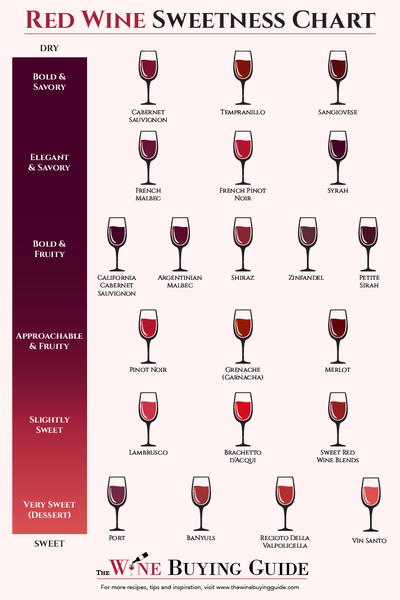Sipping on a glass of red wine can be a delightful experience, especially when exploring the world of semi-sweet varieties. Understanding the levels of sweetness in red wine can enhance your appreciation for this beloved beverage.
Let’s dive into the nuances of semi-sweet red wine, from its flavor profiles to popular selections like Cabernet Sauvignon and Pinot Noir. Join us as we uncork the secrets of Semi-Sweet Red Wine: Exploring Sweetness Levels in Red Wine.
Introduction To Semi-sweet Red Wine

Semi-Sweet Red Wine: A Delightful Choice for Wine Lovers
A Well-Balanced Pleasure: Semi-sweet red wine is a popular choice for those who enjoy a balance of sweetness and complexity. These wines offer a unique taste profile, combining fruity and sweet flavors with the depth and richness characteristic of red wines.
Smooth and Approachable: Unlike dry red wines, semi-sweet reds have lower tannin levels, making them smoother and easier to drink. This lower tannin content comes from the presence of residual sugar and leftover sugars from the fermentation process.
A Crowd-Pleasing Choice: Whether you’re a seasoned collector or just starting to explore different flavors, semi-sweet red wine is a delightful option that caters to a variety of palates.
Understanding Sweetness in Red Wine
Residual Sugar: The Key to Sweetness: The level of sweetness in red wine is determined by the amount of residual sugar, the natural sugars remaining after Fermentation. Red wines can range from dry (very little sugar) to sweet, with varying levels in between.
Impact on Flavor and Feel: This sweetness level plays a significant role in the overall flavor and texture (mouthfeel) of the wine. Understanding these variations allows wine drinkers to choose a semi-sweet red wine with the perfect balance of sweetness and acidity to suit their taste.
Finding Your Perfect Match: By using a sweetness chart or reading wine descriptions, you can discover the sweetness level that best suits your palate and enjoy a truly delightful semi-sweet red wine experience.
Light, Semi-sweet Red Wines

Light, semi-sweet red wines offer a captivating combination of delicate flavors and subtle sweetness. They cater to those who prefer a touch of sweetness without overwhelming boldness. Compared to other semi-sweet varieties, these wines boast a lower residual sugar content, resulting in a lighter and more refreshing taste.
Perfect for Every Occasion
The harmonious balance of sweetness and acidity in light, semi-sweet red wines creates a pleasing taste profile. Their smooth and approachable nature makes them perfect for various occasions. Enjoy them as an aperitif before a meal, or pair them with a delightful array of dishes. From seafood and poultry to vegetarian options, these versatile wines complement a wide range of flavors.
Popular Varieties to Explore
If you’re looking to explore light, semi-sweet red wines, here are some popular choices:
- Lambrusco: This Italian wine is known for its refreshing character. It offers a delightful combination of fruitiness and a touch of fizz.
- Brachetto d’Acqui: Another Italian gem, Brachetto d’Acqui is known for its aromatic notes of strawberries and roses. This fragrant wine is a true pleasure to experience.
- Beaujolais: Beaujolais wines originate from France’s Beaujolais region and are known for their light and fruity character. They offer hints of red berries with a touch of sweetness.
These popular varieties are just a starting point. With their inviting characteristics, light, semi-sweet red wines offer a delightful option for wine lovers around the world.
Medium Semi-sweet Red Wines
What are they?
Medium semi-sweet red wines are popular for a reason: they strike a perfect balance between sweetness and acidity. This makes them ideal for those who enjoy a hint of sweetness without going overboard. These wines typically have a residual sugar level between 20 and 75 grams per liter (g/L).
Examples and characteristics:
- Cabernet Sauvignon: This bold red offers flavors of blackberry and cassis. Its full-bodied profile makes it a great choice for those who enjoy richer wines.
- Pinot Noir: Lighter-bodied than Cabernet Sauvignon, Pinot Noir boasts notes of cherry and earthy aromas. It’s a versatile option that pairs well with a variety of dishes.
The versatility of medium semi-sweet red wines makes them a delightful addition to any meal. They can complement a wide range of dishes thanks to their balanced sweetness and acidity.
Medium semi-sweet red wines are all about harmony. The touch of sweetness enhances the rich fruit flavors, creating a smooth and luscious mouthfeel. The moderate residual sugar adds complexity without overpowering the palate.
Dark Semi-sweet Red Wines

Dark, semi-sweet red wines offer a captivating combination of depth and richness. They boast intense flavors of ripe blackberries, dark cherries, and sometimes even hints of cocoa or espresso. These wines achieve a delightful balance thanks to the interplay between their sweetness and robust tannins. The tannins add a pleasant, savory note that complements the sweetness, creating a complex and harmonious drinking experience.
Perfect Pairings for Dark Semi-Sweet Reds
The versatility of dark, semi-sweet red wines shines when it comes to food pairings. Their bold flavors and balanced sweetness can elevate a wide range of dishes.
- Savory Pairings: For a hearty and satisfying meal, pair your dark, semi-sweet red with grilled steaks or roasted game meats. The wine’s sweetness complements the richness of the meat, while the tannins act as a perfect foil for the fat, creating a well-rounded taste profile.
- Sweeter Pairings: Craving something decadent? These wines also pair beautifully with dark chocolate desserts or blue cheese. The sweetness of the wine echoes the richness of these flavors, resulting in a luxurious and satisfying combination.
Whether enjoyed on their own or alongside a delicious meal, dark, semi-sweet red wines offer a delightful taste experience for any wine lover.
Semi-sweet Red Wine Production

Crafting semi-sweet red wines requires specific methods to achieve the perfect balance between sweetness and dryness. Winemakers use several techniques to control the amount of sugar that remains in the final product.
- Stopping Fermentation Early: One approach involves halting Fermentation before all the grape sugars are converted into alcohol. This leaves behind residual sugars, contributing to the sweetness of the wine. Winemakers can achieve this through cold Fermentation, where the must (crushed grapes) is kept at a cool temperature to slow down yeast activity, or by adding neutral grape spirits to stop Fermentation completely.
- Blending for Sweetness: Another method involves blending a dry red wine with a sweeter wine or concentrated grape juice. This approach allows winemakers to adjust the final sweetness level to their desired taste profile.
Factors Affecting Sweetness
Several factors influence the final sweetness of red wine:
- Grape Variety: Certain grape varieties, like Zinfandel and Shiraz, naturally have higher sugar content, leading to wines with a more pronounced sweetness. Conversely, grapes like Cabernet Sauvignon and Merlot have lower sugar levels, resulting in drier wines.
- Winemaking Techniques: Winemaking practices, such as fermentation duration and the use of techniques to preserve residual sugars, can also significantly impact the sweetness of the final product.
In conclusion, the type of grapes used and the winemaker’s choices during production significantly influence the sweetness level in red wines. By carefully controlling Fermentation and potentially using blending techniques, winemakers can create delicious semi-sweet red wines that cater to a variety of taste preferences.
Conclusion
Love red wine but crave a touch of sweetness? Look no further than semi-sweet reds! They offer a delightful middle ground, combining bold red wine character with a touch of sweetness. This versatility, aging potential, and delicious taste make them a great choice for any wine drinker. Whether you’re a seasoned connoisseur or a curious beginner, don’t miss out on semi-sweet reds. Their balanced sweetness and complex flavors create a unique and enjoyable experience that can please even the pickiest palates. So, raise a glass and explore the delicious world of semi-sweet red wines!
Sweetness Levels in Red Wine: Key Points
Here are some key things to remember about sweetness levels in red wine:
- Semi-sweet reds strike a balance: They offer both the complexity of red wine and a touch of sweetness, making them popular among many wine drinkers.
- Taste profile matters: Understanding how sweetness levels affect taste can help you choose the right wine.
- Look for clues: Words like “off-dry” or “medium-dry” and the alcohol content can hint at a wine’s sweetness level.
By remembering these points, you can confidently navigate the world of semi-sweet red wines and find the perfect bottle for you.
Recommended Semi-Sweet Red Wine Varieties
Looking for some delicious semi-sweet red wines to try? Here are a few popular options:
- Lambrusco: This sparkling Italian red is known for its refreshing taste and fruity notes.
- Brachetto d’Acqui: Another Italian delight, Brachetto d’Acqui is a slightly fizzy wine with flavors of ripe berries and roses.
- Banyuls: Hailing from France, Banyuls is a fortified red wine with notes of dark fruits and chocolate.
These wines all offer a delightful balance of sweetness and complexity, making them perfect for those seeking a delicious semi-sweet red wine experience.
References:
- https://www.vinovest.co/blog/semi-sweet-red-wine
- https://www.kosherwinecellar.co.uk/wine-type-c1/red-wine-c2/semi-sweet-t142
FAQ about Semi-sweet Red Wine: Exploring Sweetness Levels In Red Wine
Q: What defines a semi-sweet red wine?
A: Semi-sweet red wine falls between dry and sweet wines on the sweetness spectrum. It contains residual sugar that balances the tannins, giving it a slightly sweet taste.
Q: What food pairings work well with semi-sweet red wine?
A: Semi-sweet red wine pairs beautifully with dishes that have a hint of sweetness, such as glazed ham, barbecue ribs, or spicy Asian cuisine.
Q: Why are semi-sweet red wines popular among wine enthusiasts?
A: Semi-sweet red wines offer a balance between sweetness and the complexity of red wine, making them a popular choice among wine enthusiasts.
Q: How can understanding taste profiles of different sweetness levels help in wine selection?
A: Understanding the taste profiles of different sweetness levels can help guide your wine selection and enhance your overall wine experience.
